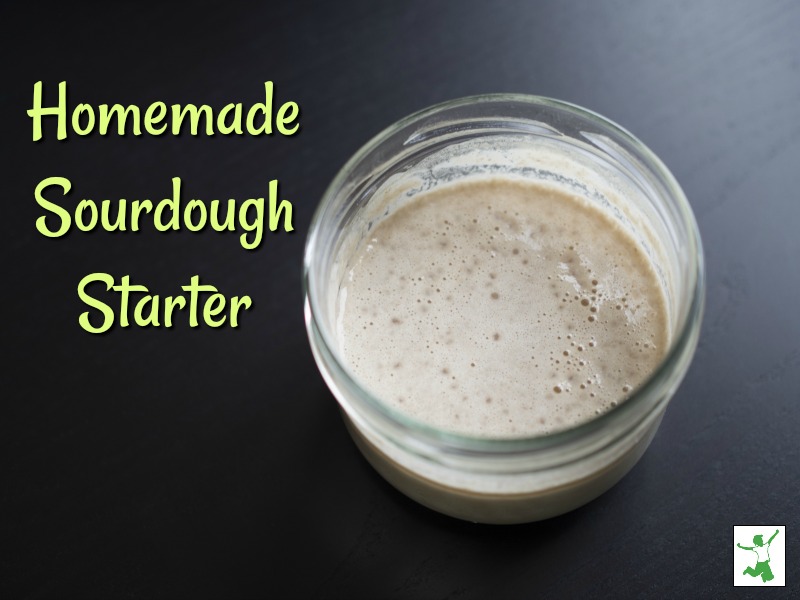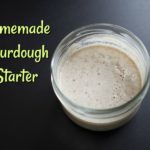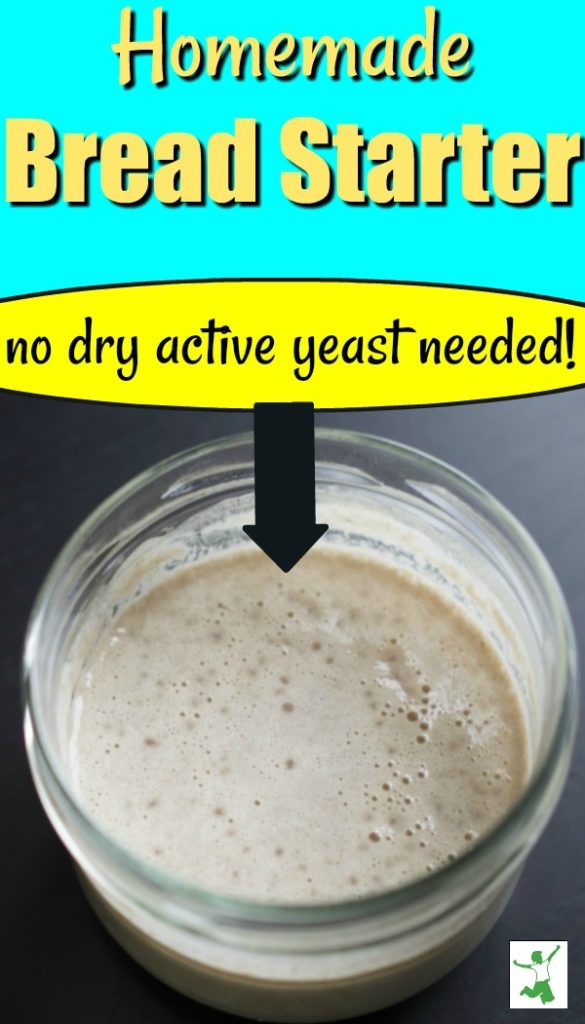Easy to follow homemade sourdough starter recipe to enjoy traditionally prepared, easy to digest sourdough bread made from whatever grain flour you choose. No active yeast required!
When I first got into Traditional Food in 2001, I pretty much had to make anything and everything myself. The reason is because there were few companies (and none in my local area) that made the type of food I was seeking. Worse, few people understood what I was even talking about! This was true even with the perennial favorite sourdough bread. My quest to learn how to make sourdough starter was usually met with puzzled expressions.
“Isn’t using yeast the proper way to get bread to rise? Isn’t this the way it’s always been done?” people would blankly ask.
“If the bread is organic, isn’t that good enough?”
Uh, no, no and no!
Yeast for breadmaking is relatively new in the grand scheme of human history. In fact, when baker’s yeast was first introduced as an alternative to true sourdough starter in France in the mid-1600s, it was strongly rejected. Renaissance scientists at the time knew that this quicker, more convenient approach to breadmaking would negatively affect public health.
Ancestrally prepared bread never contains added baker’s yeast!
Instead, traditionally baked bread utilizes a starter culture loaded with friendly Lactobacilli. This is a beneficial strain of bacteria found on the surface of all living things. Yes, it’s even crawling all over you right now if your skin is healthy and in proper pH balance.
In addition to the absence of baker’s yeast to make the bread rise, true sourdough bread as baked by traditional cultures throughout the world and by my own ancestors in Northern Europe – the type of bread ideal for my personal genome – is baked at a lower temperature for a longer period of time which protects the integrity of the proteins in the cereal grains as well as the nutritional value. This slower, more careful preparation method also eliminates anti-nutrients such as phytic acid. These substances interfere with proper digestion and block absorption of the minerals in the cereal grains. Traditional preparation also helps breaks down gluten, a very difficult to digest plant protein.
Best of all?
When you eat traditionally prepared sourdough bread (not the fake sourdoughs at the store that use yeast), you only eat a little because it is so filling!
The “bread makes you fat” argument is of much less concern when consuming traditionally prepared carbs. Eating the whole bread basket like what happens at the typical restaurant would not happen if those bread baskets were filled with true sourdough (and served with real butter of course!)
Homemade Sourdough Starter
Are you convinced yet that traditionally prepared bread is the way to go if you choose to consume carbs (which I do … I love bread!)
The next step then is to get hold of sourdough starter to try your hand at making a loaf.
Below are the directions I’ve always used to make sourdough starter, adapted, of course, from the must-have cookbook Nourishing Traditions!
Rye Flour Works Best (but you can go gluten free too)
Note that learning how to make sourdough starter really requires freshly ground rye flour. The chances of the starter “taking” are highest going this route.
If you use store-bought flour, even if organic, or another type of grain, it is likely the starter will not take and grow mold before it is ready. I know this from experience!
Note that even if your starter is made from rye, you can still use it to make sourdough bread with whatever flour you like!
To emphasize this point one more time, you will get your best results from making your sourdough starter with rye flour instead of wheat. Once your sourdough starter is ready, you can, of course, bake your bread with whatever grain you like. It’s just best to use rye for the starter alone .. you don’t have to make rye bread with it, in other words.
If you really want to make your sourdough starter with wheat, I would recommend einkorn. It is is the only heirloom wheat left on planet Earth that is completely unhybridized. By comparison, note that heirloom wheat like spelt, Kamut and emmer are hybridized! This is a frequent point of confusion.
Like rye, einkorn is lower in phytic acid and contains an easier to digest form of gluten than modern hybrid wheat. Another point to keep in mind is that while no GMO wheat currently exists on the market, most conventional wheat is toxic due to widespread desiccation practices using glyphosate-based herbicides during harvesting. Organic is going to be the safest choice for this reason.
Note that the total time to make a proper sourdough starter is one week. It doesn’t take much time each day, but you have to give the dough a chance to get “ripe” with lactobacilli.
Buying Bread Starter
It’s true. Making a sourdough culture is not a fast process. Even though it doesn’t take a lot of hands-on time, it takes a full week of waiting to let Mother Nature do her thing. And, sometimes, despite your best efforts, the sourdough starter fails and gets mold on it before the 7 days is up.
If you would rather buy starter to save time, I recommend this quality, vetted sourdough starter brand.
Gluten-free? Use this gluten-free sourdough starter instead.
Both of these types of sourdough starter are available here at 20% off.

Sourdough Starter Recipe
Easy to follow homemade sourdough starter recipe to enjoy traditionally prepared, easy to digest sourdough bread made from whichever grain you choose.
Ingredients
- 8 cups freshly ground rye flour
- 8 cups cold filtered water
- 2 large mixing bowls
- 2 fine mesh cheesecloth
Instructions
-
Day 1: Mix 2 cups flour with 2 cups of cold water. The mixture will be rather soupy. Cover with a *double* layer of cheesecloth secured by a rubber band. This will allow beneficial wild yeasts and bacteria to get into the culture but will keep critters out.
If the weather is good, set the bowl outside in the shade if you live in an unpolluted area and you don't spray any pesticides around your yard. If this is not possible, set the bowl in a warm, open area like an indoor patio.
-
Days 2-7: Every day for a total of 7 days, transfer the ripening sourdough starter to a clean bowl and add 1 cup of fresh flour plus 1 cup of cold water or even a bit more to make the mixture soupy. Cover with a fresh cheesecloth and let stand.
After a few days, you will notice the mixture begin to bubble. It will also smell a bit like wine. The frothy stage will begin to subside and after 7 days, the sourdough is ready for breadmaking!
Sourdough Starter Storage
If you need to go on vacation or take a break from breadmaking for a while, this article on how to store sourdough bread starter can help.
Whether you need to put your starter on hiatus for a week, a month, or even a full year, taking the proper precautions will save you from the process of having to make sourdough starter again later on.
Ready To Make Sourdough Bread?
This recipe for no-knead sourdough is simple and perfect for first-timers. Simply mix the ingredients together before you go to bed. In the morning, form into a rough round and bake for an hour! What could be simpler?
If you choose to buy sourdough bread rather than bake it yourself, I recommend this family-owned bakery that will ship freshly baked sourdough bread to your door.
If you are considering another brand, beware of imitation commercial sourdough! Watch out also for these common sourdough bread myths that continue to make the rounds.
Reference
More Information
Can Celiacs Eat True Sourdough Bread?
Einkorn Sourdough Crackers with Nut Butter
Benefits of Farro









Sarah. This is so similar to my recipe:) I don’t know what “freshly ground” means but In Poland we have types of flour grinding : e.g. Type 2000 means flour is made of all parts of grain, type 720 means it’s cleaner but not wihite clean in total and type 500 or 480 is basically total white clean flour. But even with type 500 of rye I am able to get sourdough starter. I usually use a mix of 2000 and 720. And it really takes time and room temperature to grow.
But what I wanted to ask: have you tried to, after mixing ingredients for bred, leave it for another 6 to 8 hours? Cause what I found once, really just because of being lazy and sleepy:) I made the dough, mixed it and left it in the pot (I usually leave unbaked bred in the moulds for 7-8 hours before baking to grow, but not that one time) and in the morning I found grown dough in the pot. So what to do to save my work? I added a cup of flour and a cup of water to “feed it”, mixed again and then put to the moulds for another 8 hours. Guess what! This bread was even better tasting. More humid after baking and kind of more sweet and felt like had added honey, but It hadn’t.
I just have a few questions. Why is so much flour and water required for this starter? I’ve read of other starters using just a tablespoon of fresh ground rye flour with a tablespoon of water and a bit of honey. Do you pour off part of the starter each time you add flour? I’m worried about it growing out of even my biggest bowl by the end! Also, do you have a link to a sourdough bread recipe using hard red and hard white wheat? I don’t have any Einkorn on hand. The recipes I’ve seen only call for tablespoons of starter being used in a batch of bread, so I’m curious as to why this starter is so big! Thanks in advance. I’m learning!
What about people with prediabetes? Doesn’t sourdough bread still have a high glycemic index?
I am interested in following this recipe but I am 100% a beginner! I am embarrassed to ask this, but how do I make fleshly ground rye flour? I don’t know what or where to buy rye in order to grind it. Also, I looked into buying the New Zealand sourdough starter from the website you recommended and it still calls for you to add rye flour to it. Is this correct or would I follow your recipe? If I did add rye to the starter, would it need to be freshly ground rye, or was freshly ground only for the starter?
Why would you be embarrassed to ask this?? It’s an excellent question, as any questions from beginners would be, and obviously most of us do not grind our own flour or know where to get it! Please have more faith in yourself that things you want to know are important questions!
I’m with you all the way until you say Einkorn is the only unhybridized flour available. It is one of the more common ones, usually lumped together with Emmer and Spelt. My severely gluten intolerant husband reacts to spelt as he does to modern wheat so I toss that one out the window. We have baked extensively with Emmer and Einkorn but find they don’t bake as well or have the flavor of Turkey Red or Red Fife. My husband is our baker and his favorite sourdough starter is a combination of Red Fife Bolted (soon to be called Sifted) and Rye.
I think you might be thinking of the term farro … einkorn is usually lumped with spelt and emmer when this term is used. Einkorn is completely unhybridized though when you separate it out from farro as emmer and spelt are indeed hybridized.
I think this is an ok area to ask… How long can I refridgerate soaked flour
mixture of : buckwheat / wholewheat flour , water , & apple cider vinigar ?
Circumstances led to over one week, & today makes 17 days ! I just looked &
there appears to be some very light mold on top . So if I scoop off the thick
top layer, is the rest safe to bake ?
Sarah, my current batch of sourdough starter is one I made with organic unbleached all-purpose flour and filtered water. I’ll be posting my way of making a starter soon, but what’s so interesting to me is that there are so many ways to do it and they all work! It’s so much fun, isn’t it!
I was hoping there would be more follow up on what to do with the starter , once I got a successful/no mold batch going? I am lost as to what to do next, recipes, storage, measurements, and so on..
have I missed it on your site somehow or ? I have searched and cannot find anything.
There is a much simpler recipe for making your own sourdough starter on the Breadtopia website, which is a fantastic site for learning the art of making your own fresh breads. The recipe calls for pineapple juice which thwarts the mold growth in the starter process and it only uses a few tablespoons of flour instead of whole cups. All in all much easier to do. Check out the recipe here:
http://www.breadtopia.com/make-your-own-sourdough-starter/